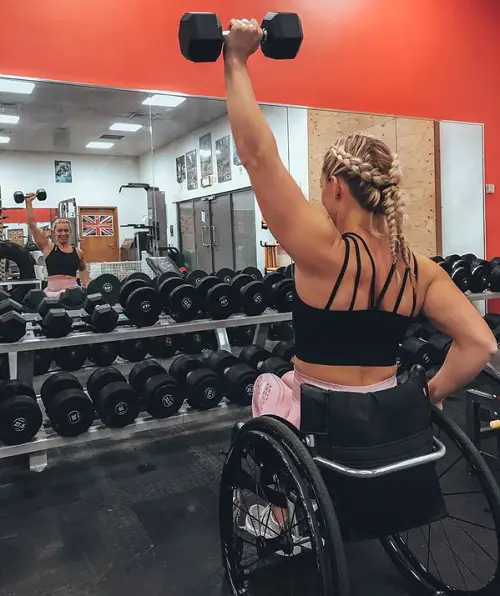
Paralympian Sophie Carrigill on how to get fit if you’re disabled
GB wheelchair basketball player, Paralympian and silver medalist Sophie Carrigill, who is an ambassador for AccessAble, shares her tips on how to keep active and exercise as a disabled person.
We all know that once a New Year begins, everyone loves to set New Year’s resolutions, me included. So far this year, I’ve actually stuck to mine!
One of the most common ones is being more active or joining a gym, probably due to the overindulgence at Christmas. It reminds people they might need to exercise more.
I’m a real believer that exercise isn’t just for your body but for your mind as well. You shouldn’t be exercising just to look a certain way or lose weight, but because it makes you feel good.
Thankfully for me, I get to exercise daily as part of my job and I really do love it. But for those of you that find it more difficult, especially when disability is added into the mix, forward planning is essential.
I hope that in sharing my experiences you may be motivated to stick to those New Year’s resolutions and not be afraid to be active.
How I started exercising as a newly-disabled person

Before I became a wheelchair user, I was a super active girl and loved playing sport. That was my way of staying fit as I hadn’t really ventured into a gym at that stage.
So after my car accident at 16 years old, during recovery, I realised how much I missed being active and playing sport.
I got in touch with a wheelchair basketball club who trained at a local leisure centre. Because it already ran disability-adapted sports, I felt confident that it had all the required accessible facilities.
I was also excited to be amongst other disabled people who were going through something similar.
I soon realised that getting fitter and stronger meant I wasn’t just getting better at wheelchair basketball – it was really benefitting my quality of life overall.
So, when I started to train with the Great Britain team, I decided it would be important and good for me to use a gym to get even stronger.
Using the gym if you’re disabled
To begin with, it was daunting! Because my disability was new, I wasn’t really sure what my body was capable of or what adaptions I would need to make.
My first coach really helped to educate me in this area. They allowed me to try things out first before we would adapt exercises.
For example, I would concentrate a lot on building my core because I knew that would really help my balance in my wheelchair. And of course, building those biceps!

But, as I said, for me it’s not about trying to look good. It’s because I use my arms for everything and my core to balance, so I know they needed to be strong.
For first-time gym-goers, I would really recommend asking one of the members of staff for some basics of where to start.
In my nearly 10 years of being a wheelchair user who uses gyms often, I’ve found that everyone I’ve ever come across is more than happy to help.
It could really help you to build up a foundation of strength and, most importantly, confidence in using gym equipment.
Looking for accessible facilities near you
Luckily for me, I had a great experience in the gym, and I love going. But I know that the gym is not for everyone.
There are plenty of other ways disabled people can get active without going to a gym. I’d recommend starting by joining a sports club to try out an adapted sport, such as wheelchair basketball like I did.
Alternatively, what about looking for a walking club that would enable you to go for long pushes around a park? Or how about seeing whether there is an accessible swimming pool near you? The important thing is that you try something to help you get active.
If you don’t know where to start to look for something near you, you can use the AccessAble website and app. The site has detailed access information about gyms, leisure centres, swimming pools and lots more venues across the country.
Remember, all of the venues included in its access guides have been visited and assessed by a trained AccessAble surveyor, so you can decide with confidence if somewhere is right for you.
- Accessible gyms
- Accessible leisure centres
- Accessible swimming pools
- Accessible walks
- Accessible golf courses
- Accessible ski centres
- Accessible trampoline parks
By Sophie Carrigall for AccessAble
More on Disability Horizons…